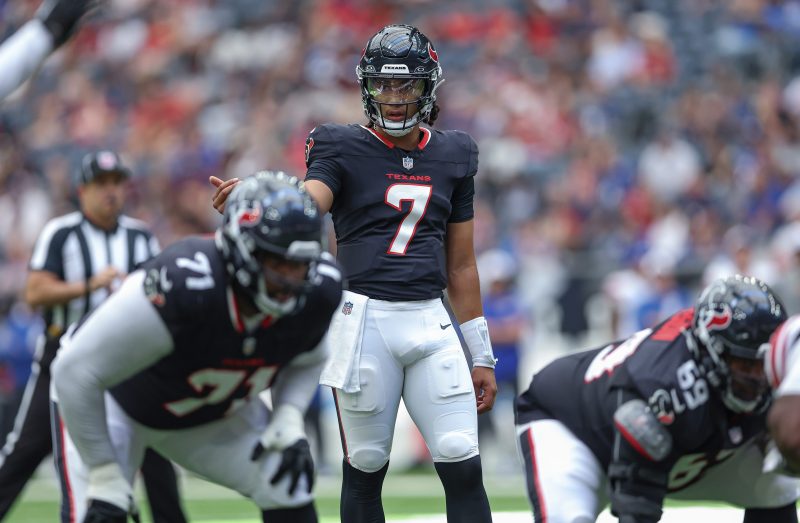The 2024 NFL season is drawing near and it’s time to assemble your championship team.
Conventional wisdom for fantasy drafters mostly stems from what 2023 served up. The previous season is consistently reflected in how players are valued within their position and how positions stack up against each other in your fantasy draft. You can take advantage of last year to assemble your draft plan.
If there are no other predraft considerations, you should at least enter your draft with a plan for your quarterback and tight end. No surprise – running backs and wide receivers are always popular and consume a major chunk of the first half of your draft. You’ll likely start at least two or three of each.
But those “single starters” of quarterbacks and tight ends need to be strategically seeded onto your roster. They are where you can get an advantage, or not, from the only player in that position that you’ll start. Improve your chances of building the optimal team by knowing what to expect.
FANTASY FOOTBALL 2024: Overall player rankings for this year’s fantasy drafts
NFL STATS CENTRAL: The latest NFL scores, schedules, odds, stats and more.
Drafting your fantasy football quarterback
This year, there are two elite quarterbacks: Josh Allen, who has been a top quarterback for four years, and Jalen Hurts. Allen goes too early, Hurts shows up in the third round in most drafts, and then the next four spread out between the fourth and sixth rounds. Patrick Mahomes, Lamar Jackson, Anthony Richardson and C.J. Stroud are difference-makers; they will all be gone and usually in that order.
The next half-dozen QBs show up by mid draft and they are nearly interchangeable in risk and reward. Mahomes drops from recent years after a “down” season but it always pays to have an advantage at quarterback as it is usually the highest-scoring position among your starters.
Recent years have promoted the “late round quarterback” theory, where drafters wait to get their starting quarterback or assume two good quarterbacks can be mixed for great results. Don’t fall for it. Get a top-scoring quarterback who is an automatic weekly starter and reap the benefits.
Fantasy football running back draft strategy
The position no longer commands the importance of recent years, but you will start two or three, and top backs are the most consistent players on your roster. Christian McCaffrey is the slam-dunk 1.01 pick in every draft after a monster 2023 season. Breece Hall and Bijan Robinson will be gone by the middle of the first round and then two to four more will be taken after all teams have picked.
Start-worthy running backs extend into the seventh round or beyond. The fantasy value declines quickly in running backs, and beyond the middle of your draft, the only remaining options are the rookies, committee players, or handcuffs for starting backs. Every year, there are at least a few backfields that slowly transition from one starter to another or experience injuries that make immediate changes to the depth chart. Consider picking Trey Benson (Cardinals), Blake Corum (Rams), Marshawn Lloyd (Packers), Bucky Irving (Buccaneers) or Ray Davis (Bills) as rookies who may be one play away from starting.
You should have two running backs by Round 7. Three is even better. Realize that the 30th running back will score about 50 fewer points than the 30th wideout, and that difference persists. Start-worthy running backs are the first position to disappear in fantasy football.
How to value wide receivers in fantasy football drafts
There’s no change from last year. Wideouts are the most popular picks in the first four rounds with between 25 and 30 selected. That means by Round 5, if you haven’t already taken two, you’ll need to get lucky. All of the WR1 and WR2 value receivers will already be gone.
With reception points, that’s a liability. Expect at least six per round and know that some teams draft three wideouts over their first four picks. The bad news is that if you want your WR1 to be an advantage, you need to pick no later than No. 8 in the first round. The good news is that wideout is the most stocked position by virtue of NFL teams relying on two or three per game.
By the sixth round, you’re looking at someone like Calvin Ridley, Christian Watson, Chris Godwin or Keenan Allen, who all have upside but also risk. Even by the 12th round, you’ll still find Brandin Cooks, Tyler Lockett, Josh Palmer or Romeo Doubs.
This year witnessed a wideout-rich NFL draft, and at least eight rookie receivers will be taken in your fantasy league. But only Marvin Harrison Jr. (Cardinals), Keon Coleman (Bills) and Malik Nabers (Giants) have a clear path to being the No. 1 wideout for their team. The rest will see less volume in their first season.
Don’t overvalue tight ends in fantasy football
Previous years saw the position serve up about three elite fantasy tight ends, while the rest of them provided minimal difference or advantage. It was either take a top-3 or accept that your tight end won’t matter. But that’s no longer true. A rookie (Sam LaPorta) topped the position in 2023, but barely over Evan Engram and Travis Kelce (who tailed off badly). The difference between the highest scorer and the No. 8 (Cole Kmet) was only 55 points, or three points per game.
That’s because of a growing influx of talented tight ends who are primarily receivers, and offenses evolving with a higher usage. The difference between the No. 1 and No. 8 in 2022 was 169 points. In 2021, it was 133. In 2020, it was 163. You do not need to grab a top-3 tight end to find a difference-maker anymore. Tight ends start later (Round 3) and the eighth one can last until Round 7. There are better ways to spend your draft capital in the earlier rounds than by using that pick on a tight end.






